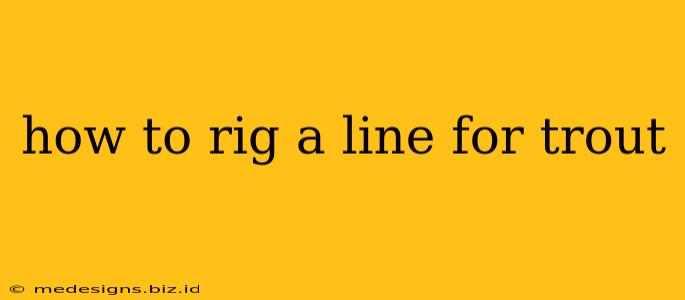Targeting trout requires finesse and the right setup. Choosing the correct line and rig significantly impacts your success. This guide covers various trout fishing rigs, helping you choose the best for different situations. We'll cover everything from simple setups to more complex rigs, ensuring you're well-equipped to land your next trophy trout.
Understanding Basic Trout Fishing Line
Before diving into rigs, let's discuss the importance of your line. Trout are notoriously line-shy, meaning they easily detect thicker lines. Therefore, selecting a suitable line diameter is crucial.
Line Types and Weights:
- Fluorocarbon: Offers low visibility, high abrasion resistance, and excellent sensitivity. Ideal for clear water conditions and discerning trout.
- Monofilament: A more affordable option, providing good strength and knot tying properties. Best suited for slightly stained or murky water.
- Braided Line: Offers high strength-to-diameter ratio, excellent sensitivity, and is more visible. While not ideal for clear water trout fishing, it's useful for situations requiring greater strength, like fishing in areas with heavy cover or larger trout.
Line Weight Considerations:
The appropriate line weight depends on the size of the trout you target and the fishing conditions. Generally, 4-6 lb test monofilament or fluorocarbon is a good starting point for most trout fishing situations. For larger trout or challenging conditions, you might consider slightly heavier lines (6-8 lb test).
Popular Trout Fishing Rigs
Here are some popular and effective trout fishing rigs:
1. The Simple Dropper Rig:
This is a fantastic beginner-friendly rig. It's incredibly versatile and effective for catching trout in various conditions.
- Components: A main line with a leader (usually fluorocarbon), a weighted fly or lure at the bottom, and a dry fly or smaller lure tied above it (the "dropper"). The weight helps the flies get down to the fish.
- Advantages: Catches trout at different water depths and effectively covers more water.
- Best For: Rivers, streams, and lakes where trout feed at multiple depths.
2. The Carolina Rig:
While traditionally used for bass, this rig can be highly effective for trout in certain situations.
- Components: A weight (usually a bullet weight) on the main line, followed by a swivel, leader, and your hook and bait (small lures, worms, or nymphs work well).
- Advantages: Allows for covering significant distance and keeps your bait off the bottom in areas with debris.
- Best For: Areas with weeds, rocks, or other obstacles on the bottom.
3. The Texas Rig:
Another versatile rig, particularly effective for fishing with soft plastic lures.
- Components: A weighted hook (often a bullet weight or a pegged weight), a soft plastic bait, and (optional) a small swivel. The weight is directly embedded in the bait.
- Advantages: Allows for weedless presentations, especially helpful in snag-filled areas.
- Best For: Areas with heavy vegetation or structure.
4. The Nymph Rig:
Specifically designed for fishing nymphs, a type of artificial fly that imitates aquatic insects.
- Components: A main line, a leader, and a nymph (or several nymphs) tied directly to the leader. Indicators (such as strike indicators or brightly colored bobbers) can be used to detect strikes.
- Advantages: Allows you to present the nymph at the precise depth trout are feeding.
- Best For: Rivers and streams where trout feed on nymphs.
Choosing the Right Rig for the Situation
The best rig for trout fishing depends on several factors:
- Water clarity: Clear water often calls for low-visibility lines and subtle presentations.
- Water depth: Deeper water may require weighted rigs to reach the trout.
- Current speed: Faster currents may necessitate heavier weights or more streamlined rigs.
- Structure: The presence of vegetation, rocks, or other obstacles influences rig selection.
- Bait/Lure choice: The type of bait or lure will often dictate the most appropriate rig.
Conclusion
Mastering different trout fishing rigs significantly improves your chances of success. Experiment with these techniques, consider the specific conditions, and adapt your approach accordingly. Remember, practice makes perfect! Get out there and enjoy the thrill of the chase!
